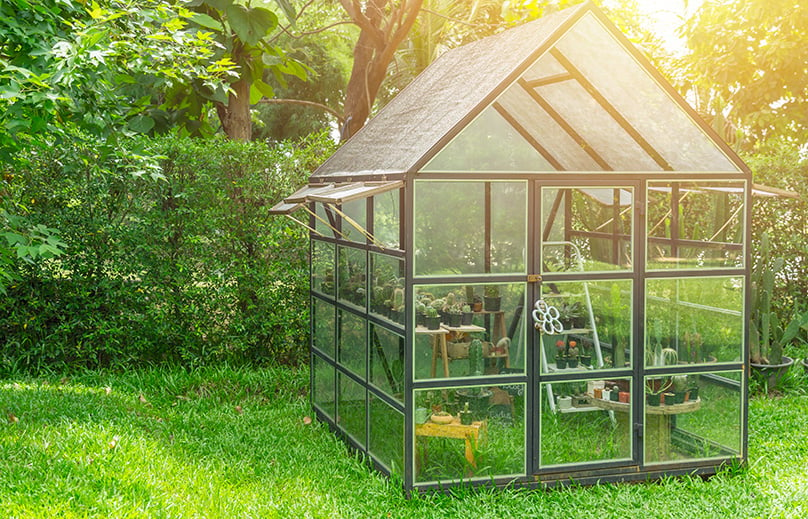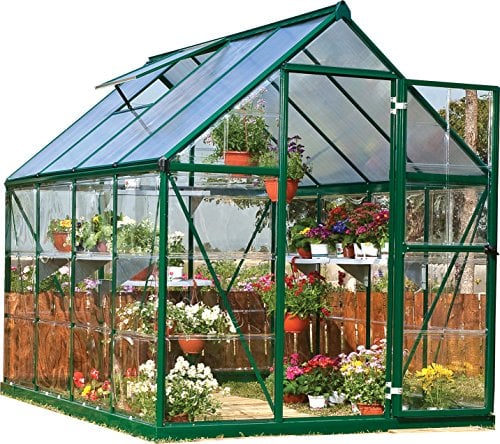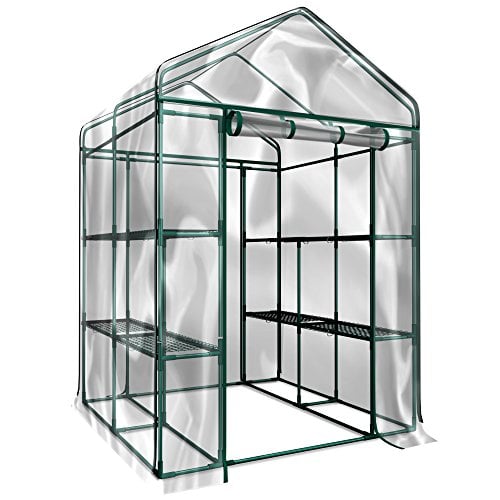Do you want to grow vegetables and flowers? Planting a garden is a rewarding experience come harvest time. However, most garden-variety vegetables and flowers don’t reach their full potential when grown outdoors.
By building a greenhouse and using it for your veggies and flowers, you provide the plants with optimal growing conditions. As a result, your vegetables and flower reach preposterous sizes. There’s a variety of components that go into building a greenhouse, and you need to understand all of them if you want to maximize the yield of your crop.
Best Selling Greenhouse Kits on Amazon
- 【Quick Setup Structure】AirWire greenhouses are designed to be easy to assemble with an intuitive quick-install system and user-friendly slide-in panels. Our team fine-tuned the installation after more than 500 rounds of rigorous testing, resulting in a 50% faster installation and 35% more stability, ensuring gardeners can enjoy cultivating flowers faster.
- 【Resistant and Sturdy】The 720g polycarbonate greenhouse features an upgraded aluminum frame for structural stability to withstand storms. It offers protection during a year-long cultivation of plants.
- 【Balanced Light】The AireWire greenhouse panel is coated with UV resistance on the outside. It can attenuate most of the harmful rays while absorbing the profitable amount of sunlight.
- 【Ventilation & Enhanced Security】Our design combines adjustable ventilation with secure access, featuring lockable doors and ventilation windows for optimal airflow and security. This ensures your plants thrive in a safe and controlled environment.
- 【Welcome to AirWire】Immerse yourself in the AirWire community, where garden days are bathed in sunlight. Our around-the-clock customer service ensures you're fully equipped, from setup assistance to seasoned gardening advice. Let's cultivate a thriving garden oasis.
- 【Quick Setup Structure】Designed for simplicity with a quick-install system and slide-in panels, our greenhouse—perfected through over 500 tests—boosts setup speed by 40% and enhances stability by 35%. This design ensures a swift, solid build, allowing gardeners to focus more on their passion for planting.
- 【Ultra-Durable Build】The VIWAT greenhouse is constructed with heavy-duty 720g/m² polycarbonate panels and a reinforced aluminum frame, offering exceptional durability. Built to withstand the elements, it provides year-round protection for your plants, ensuring a stable and enduring gardening environment.
- 【UV Guard】Our green house is equipped with panels that have a UV coating on their surfaces, ensuring your plants are protected from harmful solar radiation while maximizing sunlight exposure. This optimal balance supports healthy growth and the flourishing of vibrant blooms.
- 【Balanced Ventilation & Enhanced Security】Balanced Ventilation & Enhanced Security: Our design integrates adjustable ventilation with secure access, featuring a lockable door and vent window for both optimal air circulation and safety. This ensures your plants thrive in a secure and controlled environment.
- 【Join the VIWAT Family】Join the VIWAT family to savor life in your garden, basking in the sun's embrace. We enrich your experience with 24/7 customer support, ready to assist with assembly or offer gardening insights. Together, let's cultivate a space where joy and greenery flourish.
- WALK-IN TUNNEL GREENHOUSES- 12 double screen windows on both sides to increase air circulation, better protect your plants, equipped with drawstrings and ground pegs to effectively fix the outdoor greenhouse, We highly advised you must install the ground pegs or heavy stones to fix the greenhouse
- THICKENED PE FABRIC- 140gPE fabric is used to keep warm, humidity and prevent sun damage by blocking UV rays. Protection against the wind and severe weather
- UPGRADED GALVANIZED FRAME- The greenhouse is made of upgraded and thickened galvanized frame, which has greater support than ordinary powder-coated steel pipes, against the strong wind, rain and snow and other weather, prolong the service life, and better protect your plant
- SPECIALLY DESIGNED DOOR FIXING ROD- The fixed door crossbars are specially designed on both sides of the door to fix the door on the pole, making the zipper door more strong against the wind. The bottom of the greenhouse cloth has an extension design which you must put stones or sandbags to make it more stable
- DOUBLE ZIPPER DOORS- The greenhouse is equipped with two zipper doors, you can freely choose to enter the greenhouse from both sides, use the zipper to lock the door to protect the plants. Safety measures and professional installation are highly recommended
Last update on 2024-10-04 / Affiliate links / Images from Amazon Product Advertising API
A History of the Greenhouse
The first account of a greenhouse comes from the Roman Emperor Tiberius in the 1st century A.D. Tiberius fell ill, and his doctor recommended a diet of cucumbers to cure him of his ailments. Unfortunately, Rome was in short supply of the vegetable during the winter months.
To curb his need for cucumbers, Tiberius commanded the construction of the “specularium,” using sheets of mica and stone. A fire continually burned outside of the greenhouse, forcing the warm air into the structure. The semi-translucent rook allowed sunlight to enter the greenhouse, and Tiberius got his cucumbers.
The technology did not see any progression over the next four centuries. It wasn’t until the 16th century when Italian horticulturists started to study exotic plants that the technology advanced. Greenhouses spread quickly through Europe, with England, France, and the Netherlands all constructing various designs and concepts.
The French botanist, Jules Charles, constructed what would become the prototype of the modern greenhouse in 1599.

Types of Greenhouses
- Lean-on Greenhouses – The most significant advantage of using an attached greenhouse is that you don’t need to build a complete structure. As a bonus, you get a solid structure as one of the walls, reinforcing the stability and durability of the structure in high wind conditions. Lean-on greenhouses involve you building the structure using a perimeter wall around your property as one of the sides of the greenhouse. With a lean-on greenhouse, you save on construction costs, but you limit the amount of light entering the structure.
- Freestanding Greenhouses – you can build a freestanding greenhouse anywhere on your property. This structure needs plenty of light, so place it in an area that does not receive any shade during the day. A freestanding structure is more expensive than a lean-on, but you get more sunlight into the greenhouse, increasing the yield of your crop. A freestanding greenhouse allows you to plant your crop much earlier in the season, without it affecting the fruiting or flowering phase of your plants.

The Benefits of Growing in a Greenhouse
Growing your crop in a greenhouse has plenty of advantages over planting in normal open-air flowerbeds. You get a consistent and reliable crop with a higher yield and less environmental damage.
A greenhouse provides you an extended growing season and depending on your location; you could grow well into the fall. Some greenhouses come with heating and lighting systems that allow you to grow through the wintertime as well.
Greenhouses also allow you to grow plants and vegetables that would otherwise not be suitable for climate conditions. Greenhouses increase growing temperatures and humidity levels, giving the grower more flexibility with managing growing conditions.

If you have a problem with deer and other pests devouring your crops, and greenhouse provides excellent protection.
Plants and vegetables grown in greenhouses take in more nutrient due to the optimized growing conditions. As a result, the quality, taste, and nutrient content in greenhouse-grown produce is higher.
With a greenhouse, you get full control of growing conditions, allowing you to adjust the temperature, airflow, and light inside the structure.
Should You Build or Buy Your Greenhouse?
Greenhouses are available in kits from online retailers and nurseries. You get so many varieties of greenhouses that it’s challenging to find one that’s suitable for your application. Greenhouse kits come in different sizes, from small units that fit on a balcony, to structures that are up to 50-feet in length.
The chances are that as a home gardener, you won’t need such a large greenhouse. You’ll do better with something that’s around 10-feet long and six-feet wide, with an 8-foot roof. The most important part about constructing a greenhouse is the plastic used in the cover. This plastic needs to let in light, without filtering the beneficial UV rays.
Greenhouse kits come with everything you need to build; the structure, and it’s possible to put one together in a few hours. You don’t need to lay a foundation, and everything snaps together with connecting parts.

Building a greenhouse is far cheaper than buying a kit, costing less than a quarter of the price. However, what you make in savings, you’ll have to spend in hard work constructing the greenhouse.
If you don’t have time, and you’re not a DIY expert, then a kit is your best option. However, if you have time on your hands on the weekends, and you’re handy with tools, then building your greenhouse is the better option, and it will save you plenty of money.

Complete Walk-In Greenhouse, From Amazon
Greenhouse Glazing
As mentioned, the most critical part of the greenhouse is the cover. It is otherwise known as the “glazing” most greenhouses use specialized plastic coverings that allow maximum light into the structure.
Older greenhouses feature construction with glass, but it’s a fragile material. The glass might shatter during a hailstorm or other extreme weather event. Glass also adds a significant expense to your construction costs.
Polycarbonate is another popular glazing material, and its lightweight, durable, and transmits light very well. You can use polycarbonate on flat or curved surfaces, making it an excellent option that’s around the same price as greenhouse plastic.
Selecting Your Site
When selecting your greenhouse, the first task you need to complete is calculating your growing area. Use wooden stakes to mock-up the growing area, and use string to give you a clearer idea of how much space you need.
It’s important to note that greenhouses are a long-term investment, and you’ll need to account for increases in the growing area over the years. You’ll also need to choose a structure that lasts through multiple seasons. Look for a kit that states it has at least a 10-year warranty and service life.
The closer you build the greenhouse, the easier it is to access, and there’s more chance of you using the structure, rather than letting it lay idle. Building closer to your home also allows you to run electricity into the structure, and run water lines.
If you do decide to bring water and electricity to the greenhouse, make sure that you bury all of the supply lines at least 18-inches deep to avoid hitting it with a garden spade or pick.
Choose an area of your garden that’s level and receives full sunlight during the day — building your greenhouse in the shade results in small harvests. Your greenhouse also needs to receive at least 6-hours of sunlight during the winter months, unless you intend on using artificial lighting sources.
Orientate your greenhouse from east to west, and the largest side will receive the most sunlight. Another critical component of planning your greenhouse area is the drainage. Your soil needs to drain, or you’ll end up with root-rot on all of your plants. To improve drainage on the site, lay a 1/.4-inch layer of desiccated granite on the floor.

Erommy Walk-in Greenhouse, From Amazon
Controlling the Greenhouse Environment
All greenhouses rely on four key elements for optimal plant production; heat, air, water, and light. Let’s look at how each of these elements factors into your greenhouse environment.
- Heat – If you live in a cold environment, you can insulate the greenhouse to lock in the heat at night and protect your plants. Some gardeners also like to use greenhouse heaters attached to a thermocouple to maintain the ideal temperature as the seasons start to change. As a DIY heating option, you can fill barrel drums with desiccated granite. The stones absorb the heat from the sun’s rays during the day and release it into the greenhouse during the night. Planting in old tires also creates a similar effect, keeping the roots of your flowers and vegetables warm during the night.
- Water – You’ll need to have your greenhouse near a water source. Plants growing in greenhouses have higher water requirements than those growing in outdoor flowerbeds.
- Air – Most greenhouses come with ventilation to prevent the structure from overheating and killing your plants. Some kits have an adjustable roof, while others allow you to lift the side skirting around the greenhouse.
- Light – Greenhouses need full sunlight throughout the day. If the temperatures get too hot, you can always use the ventilation system to bring the heat down inside the greenhouse. However, in the winter season, sunlight hours diminish substantially. By adding a grow lamp into your greenhouse, you can keep your plants growing through all of the seasons.
Greenhouses Mold and Pests
Greenhouses are not immune to pest infestations. When bugs find their way into your greenhouse, it’s like they landed in paradise. Pests can destroy your crop quickly if you don’t get them under control. Always check your plants before bringing them into the greenhouse.
Another problem that greenhouse gardeners experience is mold growth. Mold and fungus can ruin your harvest, and the pathogens overwinter in the soil, infecting the following season’s crop.
Plan your growing area to include a section for rotating your crops. This strategy allows you to recover your soil in the next season. Many gardeners make use of a sulfur burner inside the greenhouse to eliminate any mold issues.
Pots or Flowerbeds?
When growing in a greenhouse, you have the option of using pots or raised flowerbeds for your plants. Either choice is good, and both have advantages and disadvantages.
With pots, you get the advantage of portability. If any of your plants experience insect infestation, then you can remove them from the greenhouse before the disease spreads to the rest of your crop. Using material pots also increases the airflow to the roots, resulting in larger yields at harvest time.
A raised flowerbed is also a good option, but you lose the portability that you get with pots. However, with a raised bed, you can cultivate your soil, and you have more room for roots to grow, which is beneficial for larger plants.
Greenhouse Accessories
There are countless accessories you can add to your greenhouse to improve its performance and reduce the effort it takes in managing your crop. Depending on your budget, you could add automated vent systems, misting and heating systems, fans, tool racks, potting benches, and the list goes on.
We recommend that you keep the floor space of your greenhouse as free as possible to maximize your growing area. You can hang baskets from the roof of the greenhouse to hold your nutrients, tools, and seeds.

Raised Garden Bed with Self Watering Planter Box, From Amazon
Planting in Cold Vs. Warm Weather
Owning a greenhouse allows you to plant crops year-round. However, growing in the winter season may increase your costs. Electricity to run a grow lamp can set you back hundreds of dollars for the season. Therefore, we recommend that you investigate solar power if you decide to bring electricity into the greenhouse.
Planting during the colder winter months of December and January suits root vegetables like beets, onions, carrots, and leafy greens like chard and kale. As the weather starts to get warmer in the spring, you can plant broccoli, beans, tomatoes, peppers, and squash.
It will take you a season or two to master controlling the environment in the greenhouse, and discovering which plants and veggies suit changing environmental conditions.
In Closing – A Greenhouse is Your Path to Sustainable Food
By growing your food in a greenhouse, you create sustainable living conditions for you and your family. Many gardeners grow more than they can eat, allowing them to provide food for other people in the community. Try selling your extra vegetables to people in your neighborhood. This strategy helps you to offset the costs of building your Greenhouse.



